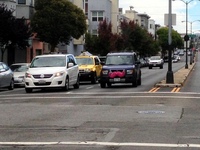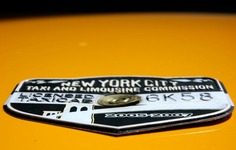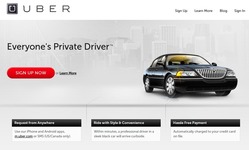 |
| Angelika/Mike Schilli |
|
Michael If you've ever tried to get a taxi cab in San Francisco after a heavy rain storm, you'd agree with me that there are deficiencies here in this town, just as if we were worshipping some destructive form of socialism. It's hard to believe, but in major American cities like New York City, San Francisco, Boston or Chicago, there's no free market for taxi drivers. Instead, these cities impose restrictions on the number of cabs in operation and hence create artificial bottlenecks on days with high demand.
What's happening is that these cities issue a limited number of so-called "Medallions" that no cab can be operated without. Like in a Mafia-controlled operation, wealthy middlemen are trading these licenses for millions of dollars and rent them out to taxi drivers on a daily basis. On top of paying the daily renting fee for a vehicle, taxi drivers therefore have the additional financial burden of having to compensate the medallion owner, before they even see a single cent of their income during a shift. In New York city, for example, a driver taking in $300 during a 12 hour shift pays about $150 to the taxi cab mogule who rents out the yellow cab with the embedded medallion.
Naturally, the swanky medallion owners defend this midevil bureaucracy tooth and nail against all efforts to align it with modern consumer requirements. Sure, who in their right mind would let go of a licence to print money? What's worse, the cab drivers aren't eager to introduce a free market either. More cabs lead to more competition and hence lower hourly wages. However, it's the customers who get the short end of the stick in this game, because they can forget about getting from point A to B on days with increased demand. Those of you who have ever tried to get a cab on New Year's Eve, grudgingly have given up at some point, only to finally take hopelessly crowded street cars across town, would most likely agree with me.
For this reason, a while ago, a startup company named "Uber" set out to offer black limousine rides for customers who were willing to pay roughly twice the regular cab fare. Their cars are often Lincoln Towncars, driven by chauffeurs in uniforms. You can't hail them like regular cabs, but need to page them via SMS message or a smart phone app within minutes. On a map, customers can watch the limo approaching. When arriving at the destination, customers make a digital payment via the smart phone, and the tip is included. Customers can then rate the driver and get an invoice via email. Since no cash is changes hands, Uber drivers feel safe to even to enter the shadier neigborhoods of San Francisco, where regular cab drivers usually start shaking and stay out!
Predictably, in almost every city Uber enters, the established taxi cab overlords raise a legal storm. In May 2012, they shut Uber down in Boston temporarily. Uber obviously walks a fine legal line and argues that they're not bound by the taxi restrictions because they're not operating taxi cabs, but offer a completely different transportation experience.
Uber's headquarters are located in San Francisco, where the new service has been received with great success, but recently a new contender has emerged: Private cars with a grotesquely large pink mustache on the front grill, called "car stache" in short. Behind this new service hides a startup company named "Lyft". Customers request their rides by smart phone app and pay the driver at the end of the ride via the app with a stored credit card. The money exchange isn't called "cab fare" for legal reasons, but a "donation" that the driver "suggests" and is about 20% less than the fare for a comparable cab ride.
After drop-off, both driver and customer rate the experience separately via the app. That way, the customer can reward the driver for driving courteously, and conversely the driver acknowledges that the customer's "voluntary" payment was considered adequate. Lyft pays new drivers an hourly wage of $18 during the first couple of weeks. As soon as drivers have established a customer base, their income is determined entirely by what they receive from customers, of which they may keep 80%. It seems that Lyft's workforce solely consists of young people who want to make a few bucks on the side. Drivers greet their customers with a so-called "fist-bump", a modern urban gesture, where two people make a fist with their right hand and slowly move them together until they gently touch at the knuckles.















